Chapter 8: Accounting for overheads
Chapter learning objectives
Upon completion of this chapter you will be able to:
- explain the different treatment of direct and indirect expenses
- describe the procedures involved in determining production overhead absorption rates
- allocate and apportion production overheads to cost centres using an appropriate basis
- reapportion service cost centre costs to production cost centres (using the reciprocal method where service cost centres work for each other)
- select, apply and discuss appropriate bases for absorption rates
- prepare journal and ledger entries for manufacturing overheads incurred and absorbed
- calculate and explain the under- and over-absorption of overheads
1 Direct and indirect expenses
 Direct expensesare expenses that can be directly identified with a specific cost unitor cost centre. There are few examples of direct expenses but royaltiespaid to a designer or fees paid to a subcontractor for a specific jobcould be classed as direct expenses.
Direct expensesare expenses that can be directly identified with a specific cost unitor cost centre. There are few examples of direct expenses but royaltiespaid to a designer or fees paid to a subcontractor for a specific jobcould be classed as direct expenses.
- Direct expenses are part of the prime cost of a product.
Indirect expenses cannot be directly identified with a specific cost unit or cost centre.
- For example, the cost of renting a factory where shirts are manufactured is classified as an indirect cost because it would be impossible to relate such costs to shirts only, if other clothes, such as dresses and suits were also made in the same factory.
- Indirect expenses are also known as overheads.
2 Production overhead absorption
Fixed production overheads
 Production overheads are the total of indirect production costs:
Production overheads are the total of indirect production costs:
Fixed production overheads = indirect materials + indirect labour + indirect expenses
- Fixed production overheads of a factory will include the following costs:
- heating the factory
- lighting the factory
- renting the factory.
- The total cost of a product also includes a share of the fixed production overheads.
- This is because organisations must recover their fixed production overheads and they do this by absorbing a fixed amount into each product that they make and sell.
Absorption costing
Production overheads are recovered by absorbing them into the costof a product and this process is therefore called absorption costing.
- The main aim of absorption costing is to recover overheads in a way that fairly reflects the amount of time and effort that has gone into making a product or service.
- Absorption costing involves the following stages:
- allocation and apportionment of overheads
- reapportionment of service (non-production) cost centre overheads
- absorption of overheads.
3 Allocation and apportionment
Allocation and apportionment of overheads
The first stage of the absorption costing process involves the allocation and apportionment of overheads.
- Allocation involves charging overheads directly to specific departments (production and service).
- If overheads relate to more than one specific department, then they must be shared between these departments using a method known as apportionment.
- Overheads must be apportioned between different production and service departments on a fair basis.
Bases of apportionment
There are no hard and fast rules for which basis of apportionmentto use except that whichever method is used to apportion overheads, itmust be fair. Possible bases of apportionment include the following:
- floor area – for rent and rates overheads
- net book value (NBV) of fixed assets – for depreciation and insurance of machinery
- number of employees – for canteen costs.

 Illustration 1 – Allocation and apportionment
Illustration 1 – Allocation and apportionment
LS Ltd has two production departments (Assembly and Finishing) and two service departments (Maintenance and Canteen).
The following are budgeted costs for the next period:

The following information is available:

Required:
Complete the extract from the overhead analysis sheet shown below.
Overhead analysis sheet



 Solution
Solution
Overhead analysis sheet

Workings:
(W1)
Indirect materials are allocated directly to the relevant departments.
(W2)
Rent is apportioned to all departments based on the area occupied.
Total rent cost = $15,000
Total area occupied = (1,000 + 2,000 + 500 + 500) sq metres= 4,000 sq metres
Apportioned to Assembly department = 1,000/4,000 x $15,000= $3,750
(W3)
Direct labour is not an overhead and is therefore not part of the overhead allocation and apportionment process.
(W4)
Electricity is apportioned to all departments on the basis of kW hours.

(W5)
Machine depreciation is apportioned to all departments on the basis of machine value.

(W6)
Indirect labour costs are allocated directly to all departments based on the indirect labour budget for each department.

4 Reapportionment of service cost centre costs to production cost centres
Reapportionment
Service cost centres (departments) are not directly involved inmaking products and therefore the fixed production overheads of servicecost centres must be shared out between the production cost centres(departments) using a suitable basis.
- Examples of service cost centres are as follows:
- stores
- canteen
- maintenance department
- payroll department.
Basic reapportionment
- The basic method of reapportionment is used when one service department works or provides a service for other service department as well as the production departments
- Using the example in the previous illustration – the canteen feeds all the staff that work for the company in maintenance, finishing and assembly but the maintenance staff do not provide support for the canteen equipment.

 Illustration 2 – Reapportionment of service cost centre costs
Illustration 2 – Reapportionment of service cost centre costs
The total overheads allocated and apportioned to the production and service departments of LS Ltd are as follows:

A suitable basis for sharing out the maintenance costs is the timespent servicing equipment. The amount of time spent by the maintenancedepartment servicing equipment in the Assembly and Finishing departmentshas been analysed as follows:
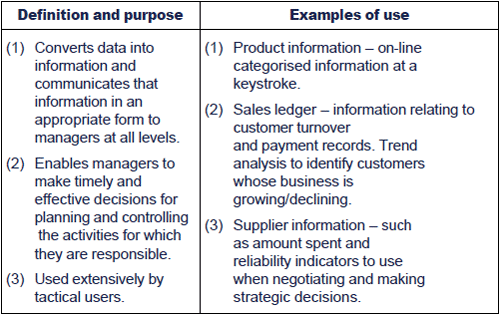
The Canteen department's overheads are to be reapportioned on thebasis of the number of employees in the other three departments.

Required:
Complete the overhead analysis sheet overleaf.
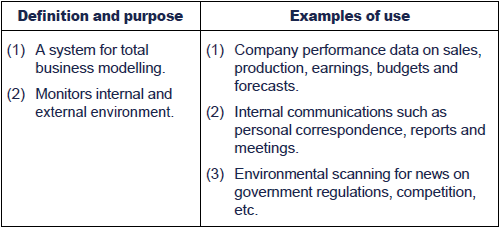


 Solution
Solution
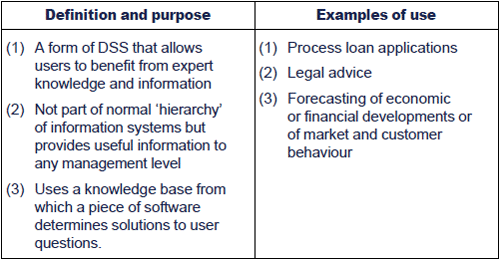
Workings:
(W1)
Canteen overheads are reapportioned on the basis of number of employees.
Total employees = 20 + 30 + 10 = 60
Reapportioned to Assembly department = 20/60 x $6,600 = $2,200
(W2)
Assembly = 60% x $19,700 = $11,820
Maintenance = 40% x $19,700 = $7,880
The overhead analysis sheet that you have just completed demonstrates the basic method of service department reapportionment.


 Test your understanding 1
Test your understanding 1
A manufacturing company runs two production cost centres C1 and C2,and two service cost centres S1 and S2. The total allocated andapportioned overheads for each is as follows:
It has been estimated that each service cost centre does work for other cost centres in the following proportions:
After the reapportionment of service cost centre costs has beencarried out, what is the total overhead for production cost centre C1?
A $17,700
B $19,140
C $21,940
D $23,240

Reciprocal reapportionment
Reciprocal reapportionment (or the repeated distribution method) isused where service cost centres (departments) do work for each other.
- It involves carrying out many reapportionments until all of the service departments' overheads have been reapportioned to the production departments.

 Illustration 3 – Reapportionment of service cost centre costs
Illustration 3 – Reapportionment of service cost centre costs
The total overheads allocated and apportioned to the production and service departments of LS Ltd are as follows.
Assembly = $17,350
Finishing = $23,970
Maintenance = $18,600
Canteen = $6,600
A suitable basis for sharing out the maintenance costs is the timespent servicing equipment. The amount of time spent by the maintenancedepartment servicing equipment in the other three departments has beenanalysed as follows.

The Canteen department's overheads are to be reapportioned on thebasis of the number of employees in the other three departments.

Complete the overhead analysis sheet below and reapportion the service departments' overheads to the production departments.
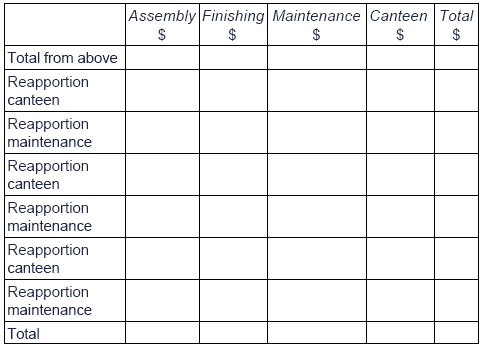


 Solution
Solution



 Test your understanding 2
Test your understanding 2
A company has three production departments, Alpha, Beta and Gamma,and two service departments, Maintenance (M) and Payroll (P). Thefollowing table shows how costs have been allocated and the relativeusage of each service department by other departments.

Required
Complete the overhead analysis sheet below and reapportion theservice department overheads to the production departments using thereciprocal method.
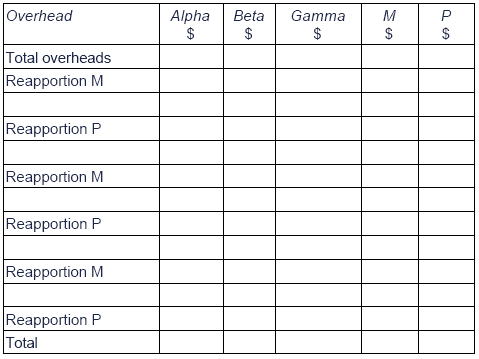

5 Absorption of overheads
Bases of absorption
Once the overheads are allocated and apportioned into theproduction departments the overheads need to be related to or absorbedinto the units of product.
- Overheads can also be absorbed into cost units using the following absorption bases:
- units produced
- machine-hour rate (when production is machine intensive)
- labour-hour rate (when production is labour intensive)
- percentage of prime cost
- percentage of direct wages.
- Production overheads are usually calculated at the beginning of an accounting period in order to determine how much cost to assign a unit before calculating a selling price
- The overhead absorption rate (OAR) is calculated as follows:
- The absorption basis is most commonly units of a product, labour hours, or machine hours.
Departmental OARs
It is usual for a product to pass through more than one departmentduring the production process. Each department will normally have aseparate departmental OAR.
- For example, a machining department will probably use a machine-hour OAR.
- Similarly, a labour-intensive department will probably use a labour-hour OAR.
- An alternative to a departmental OAR is what is termed a blanket OAR.
- With blanket OARs, only one absorption rate is calculated for the entire factory regardless of the departments involved in production.
- Blanket OARs are also known as single factory-wide OARs.

 Illustration 4 – Production overhead absorption
Illustration 4 – Production overhead absorption
RS Ltd is a manufacturing company producing Product P, which has the following cost card.

RS Ltd produces and sells 1,000 units in a month. RS absorbed overheads based on the number of units produced.
Based on past experience, RS Ltd estimates its monthly overheads will be as follows.




 Solution
Solution

Workings
The overhead per unit is $5,500/1,000 = $5.50 per unit.
The cost per unit is:



 Illustration 5 – Appropriate bases for absorption rates
Illustration 5 – Appropriate bases for absorption rates
Ballard Ltd makes three products A, B and C. Each passes through two departments: Machining and Assembly.
Labour hours used in each department by each product

Production is expected to be as follows:

Overheads are budgeted as follows:
Complete the following.



 Solution
Solution

Workings

Using a blanket OAR:


Product B – Machining department overhead = 2 hours × $20 = $40
Product B – Assembly department overhead = 0.5 hours × $37.50 = $18.75


 Test your understanding 3
Test your understanding 3
The Major Gnome Manufacturing Company has two departments –Moulding and Painting – and uses a single production OAR based ondirect labour hours. The budget and actual data for Period 6 are givenbelow:
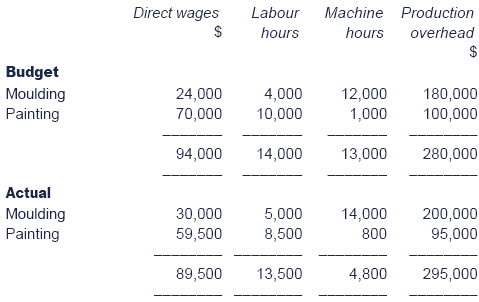
During Period 6, a batch of Pixie Gnomes was made, with the following costs and times:

The direct material cost of the batch was $890.
Complete the following.

It has been suggested that appropriate departmental OARs may be more realistic.
(b) The OAR in:
(c) Using departmental OARs, the cost of the batch of Pixie Gnomes is $

6 Under- and over-absorption of overheads
Under- and over-absorption of overheads
If either or both of the estimates for the budgeted overheads orthe budgeted level of activity are different from the actual results forthe year then this will lead to one of the following:
- under-absorption (recovery) of overheads
- over-absorption (recovery) of overheads.
Calculating an under- or over-absorption
There is a three step procedure:
Step 1 – calculate the OAR (based on budget)

Step 2 – calculate the overhead absorbed by actual activity
Overheads absorbed = predetermined OAR × actual level of activity
Step 3 – Compare absorbed to actual
If at the end of this period, the overheads absorbed are greaterthan the actual overheads, then there has been an over-absorption ofoverheads.
If, on the other hand, the overheads absorbed are less than theactual overheads, then there has been an under-absorption of overheads.

 Illustration 6 – Under- and over-absorption of overheads
Illustration 6 – Under- and over-absorption of overheads
The following data relate to Lola Ltd for Period 8.




 Solution
Solution

Workings




 Test your understanding 4
Test your understanding 4
The following data relate to Lola Ltd for Period 9.


Working backwards
Sometimes you may be given information relating to the actualunder- or over-absorption in a period and be expected to calculate thebudgeted overheads or the actual number of hours worked.

 Approach to working backwards
Approach to working backwards
- As long as you remember the basic formula involved in calculating under/over-absorption, you shouldn't have any problems.
- The main thing to remember is that if actual overheads are greater than absorbed overheads then we have under-absorption and any under-absorbed overheads need to be deducted from actual overheads incurred in order to calculate the actual overheads absorbed.
- Similarly, if over-absorption occurs, the over-absorbed overhead needs to be added to actual overhead in order to calculate the actual overheads absorbed.


 Illustration 7 – Under- and over-absorption of overheads
Illustration 7 – Under- and over-absorption of overheads
A business absorbs its fixed production overhead on the basis ofdirect labour hours. The budgeted direct labour hours for week 24 were4,200. During that week 4,050 direct labour hours were worked and theproduction overhead incurred was $16,700. The overhead wasunder-absorbed by $1,310.



 Solution
Solution

Working

Budgeted fixed overhead = 4,200 × $3.80 = $15,960


 Test your understanding 5
Test your understanding 5
A business absorbs its fixed overheads on the basis of machinehours worked. The following figures are available for the month of June:

If there was an over-absorption of overhead of $3,500, how many machine hours were worked in the month?
A 30,334
B 32,667
C 35,000
D 49,000

7 Journal and ledger entries for manufacturing overheads
Production overheads account
The direct costs of production (materials, labour and expenses) aredebited in the work-in-progress (WIP) account. Indirect productioncosts are collected in the production overheads account.
- Non-production overheads are debited to one of the following:
- administration overheads account
- selling overheads account
- distribution overheads account
- finance overheads account.
- Production overheads, as you will remember, include rent and rates, indirect materials and indirect labour costs.
- Absorbed production overheads are credited to the production overheads account.
- Any difference between the actual and absorbed overheads is known as the under- or over-absorbed overhead and is transferred to the income statement at the end of an accounting period.

 Illustration 8 – Journal and ledger entries for manufacturing overheads
Illustration 8 – Journal and ledger entries for manufacturing overheads
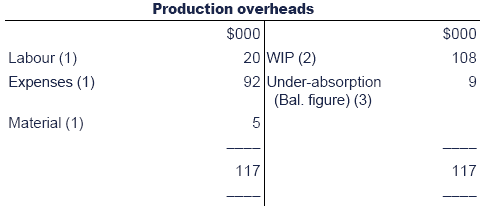

(1) The production overheads accountacts as a collecting place for all the indirect costs of a productionprocess. All the costs are debited to this account.
(2) Production overheads are absorbedinto production on the basis of actual activity. The absorbed overheadsare 'credited out' of the production overheads account and transferredto the WIP account where they are added to the cost of production, andhence the cost of sales.
(3) The difference between the overheadsabsorbed and the overheads actually incurred is known as the under- orover-absorbed overhead. This is a balancing figure and is transferred tothe Over/under-absorption of overheads account. A credit balancingamount is an over-absorption and a debit balancing amount is anunder-absorption.
(4) At the end of an accounting period,the balance on the over/under-absorption account is transferred to theincome statement where it is written off (under-absorbed overhead) orincreases profit (over-absorbed overhead).


 Test your understanding 6
Test your understanding 6
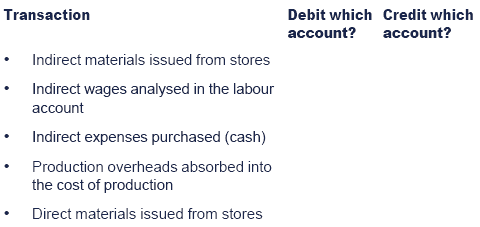

8 Chapter summary
Test your understanding answers

 Test your understanding 1
Test your understanding 1
C
Allocated and apportioned overheads $12,000
Add: reapportionment of S1: 60% x $9,500 = $5,700
Add: reapportionment of S2 overhead apportioned to S1: $8000 x 30% x 60% = $1,440
Add: reapportionment of S2: 35% x $8,000 = $2,800
Total = $21,940


 Test your understanding 2
Test your understanding 2

Alternative answer (using equations)
M = 2,500 + 20% P
and
P = 2,700 + 25% M
Substitute the equation for P into the equation for M to have one unknown:
M = 2,500 + 20% (2,700 + 25% M)
Turn the percentages to decimals and multiply out the brackets:
M = 2,500 + (0.2 × 2,700) + (0.2 × 0.25M)
M = 2,500 + 540 + 0.05M
Put the unknowns together:
M – 0.05M = 2,500 + 540
0.95M = 3,040
Calculate was M equals:
M = 3,040 / 0.95
M = 3,200
Go to original equations to calculate P:
P = 2,700 + 25% M
P = 2,700 + 0.25 × 3,200
P = 3,500
Using the percentages in the original data for Alpha, Beta andGamma we can calculate how much overhead each department receives:
Alpha = 3,000 + (20% × 3,200) + (25% × 3,500)
Alpha = $4,515
Beta = 4,000 + (30% × 3,200) + (25% × 3,500)
Beta = $5,835
Gamma = 2,000 + (25% × 3,200) + (30% × 3,500)
Gamma = $3,850


 Test your understanding 3
Test your understanding 3

It has been suggested that appropriate departmental OARs may be more realistic.
(b) The OAR in:


Workings

(a) Cost of batch of Pixie Gnomes
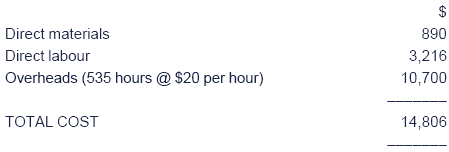
(b)

(c) Cost of a batch of Pixie Gnomes using separate departmental OARs
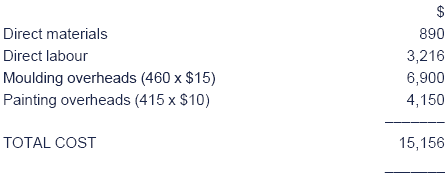


 Test your understanding 4
Test your understanding 4
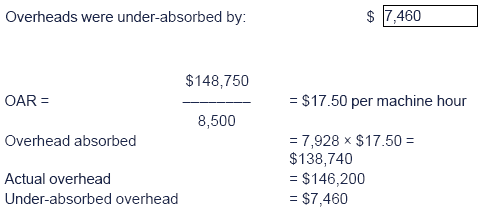


 Test your understanding 5
Test your understanding 5
C
35,000 machine hours were worked in the month.
Workings




 Test your understanding 6
Test your understanding 6


|
Created at 5/24/2012 5:14 PM by System Account
(GMT) Greenwich Mean Time : Dublin, Edinburgh, Lisbon, London
|
Last modified at 5/25/2012 12:53 PM by System Account
(GMT) Greenwich Mean Time : Dublin, Edinburgh, Lisbon, London
|
|
|
|
 |
Rating
:
|
 Ratings & Comments
(Click the stars to rate the page) Ratings & Comments
(Click the stars to rate the page)
|
 |
Tags:
|
|
|
|
|